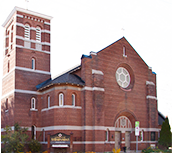The Great Litany
By Rev. Canon Stewart Murray, Incumbent at St. Barnabas, Ottawa
One of the great treasures of our Anglican tradition that I have rediscovered in the last few years is the Great Litany in the Book of Common Prayer (BCP) and the Book of Alternative Services (BAS). At one time it was common to find a copy of the Litany in a separate book on a prayer desk, called a litany desk, in the sanctuary or nave of most churches. The BCP suggests that the Litany be used as a form of intercession and petition “at least once a month on a Sunday”. I remember as a chorister at St. Matthew’s learning to sing the Litany and finding it both tedious and fascinating as we prayed for the world and all sorts of people, from the Queen to women laboring of child, and for all in danger, necessity or tribulation. Since being appointed to St. Barnabas, I have come to love praying the Litany twice a year, at the beginning of Advent and of Lent, in procession on a Sunday morning, with the choir and congregation joining in the chorus of the prayer. I have also tried to make a practice of praying the Litany privately as part of my prayer discipline.
This Litany as a form of prayer is of ancient origin, first recorded in the liturgies of Antioch in the 4th century. The word litany in Greek means prayer or supplication. The version found in the BCP was first translated from the Latin and adapted in 1544 by Thomas Cranmer. It is humbling to realize that when we pray the Litany we are joining our prayers with all who have prayed it for over 450 years. It is a model that can help us to grow in prayer and to fulfill our mission as people who are called to intercede for all of God’s creation.
The Litany begins with prayer to the Holy Trinity as a reminder that the source and focus of our prayer must always be on our union with the loving and life-giving Trinity. It also invites us to enter prayer with a spirit of humility, awe and a deep awareness of our redemption through Christ. The Litany always balances the awareness of our sin and our brokenness with awareness of forgiveness and redemption through Christ. “Remember not, Lord, our offences… spare thy people, whom thou hast redeemed with thy most precious blood.”
The Litany, as it unfolds, focuses our prayer first on spiritual dangers that can destroy our souls and turn us away from the love of God: “From all blindness of heart, from pride, vainglory and hypocrisy…”; then on the physical dangers that can destroy our bodies: “From lightning and tempest; from earthquake, fire and flood…”; followed by the reminder that by the grace of God, “by the mystery of thy Holy Incarnation…” we are saved from spiritual and physical ruin.
The longest section of the Litany invites us to pray for the Church, the state, our country, for peace and for a variety of people and situations common to us all, for widows, all who travel, for the sick, and, in the eloquent phrase, “for all who are desolate and oppressed”.
I find the breadth and depth of the Litany a gift to guide me in my life of prayer. The format of the Litany enables us to remember all the key values in our life together in Christ – mercy and forgiveness, our desire for peace, unity and healing. It is a reminder that God in Christ shares in the joys and challenges of living in our wonderful but often troubled world and of God’s desire that all of us may, in a paraphrase of the words of the Litany, hear meekly the Word, receive it with pure affection, and bring forth the fruit of the Spirit.
I invite you to discover the beauty of the Litany either in the BCP (p. 30) or the BAS (p. 138), and to allow the Holy Spirit to help you pray it with joy and in thanksgiving for all of God’s blessings in Christ.

